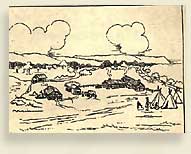Territorial Timeline

Whitman Massacre - The first major conflict between Northwest Indians and whites
In 1836 Dr. Marcus and Narcissa Whitman established a Methodist mission at Waiilatpu, about six miles west of the present-day city of Walla Walla. With the help of several assistants and workmen, Marcus and Narcissa attempted to instruct the neighboring Cayuse Indians in Christianity and tried to teach them the skills they would need to be successful farmers and ranchers. After 1842 the Whitman Mission also became an important stopping place for pioneer wagon trains heading west on the Oregon Trail.
For ten years the Whitman Mission was relatively successful and the Indians respected the Whitmans. However, by 1847 things began to change. Every year brought an increase in the number of wagon trains and the Indians began to fear the settlers would steal their lands. With the pioneers came diseases to which the Indians had no resistance. In 1847 a measles epidemic swept through the Indian villages, and although Dr. Whitman tried to treat the Indians, rumors spread that he was infecting the Indians by giving them disease carrying blankets.
On March 29, 1847 a group of Indians entered the mission grounds, apparently on a friendly visit, but with weapons concealed in their clothing. When two of the Indians met Dr. Whitman in the mission kitchen, one engaged him in conversation while the other one gave him a fatal blow from behind - that was the signal to begin the attack. Of the 72 people staying at the mission, fourteen were killed including both Marcus and Narcissa. The Indians captured 54 women and children and held them hostage, but a few people escaped in the confusion. Twelve days later the Hudson's Bay Company ransomed the captives. The ransom consisted of 62 blankets, 63 cotton shirts, 12 muskets, 600 loads of ammunition, 37 lbs. of tobacco, and 12 flints.
News of the Whitman Massacre quickly spread. The Oregon Provisional Government raised a volunteer army to fight the Indians, resulting in the Cayuse War of 1848-50. Unfortunately this incident marked the beginning of Indian conflicts that would last for years.